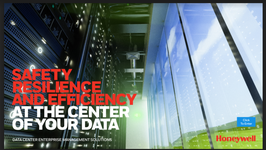There are approximately three million data centers worldwide, delivering an essential enterprise service to businesses of all types. In fact, most of the world’s Internet Protocol (IP) traffic is routed through data centers. There is also an increasing awareness that the data center industry has a growing carbon footprint. Therefore, there are calls to minimize its power consumption while optimizing resiliency.
Data center owners and facility managers are left with a complex puzzle – how to cater to growing demand, while at the same time lowering energy usage and eliminate downtime. Any approach that starts to solve this problem often has the additional benefit of reducing overheads and protecting bottom line performance. The good news is that energy reduction of up to 15 percent can often be achieved through an integrated approach to building management.
Meeting the energy needs
As the largest consumer of energy within a data center is the core IT, server consolidation can help reduce energy use, but the building itself typically plays a significant role in energy management. It is therefore advisable to investigate some simple structural steps that could help reduce energy consumption. For example, condition-based maintenance (CBM) can help optimize the operation of ventilation systems, air handling units and chillers by using machine learning. Upgrades to existing systems can help deliver valuable savings. However, the biggest likely improvements will often come from integrating a site’s management control systems. By being better able to monitor and control building services, facilities managers can leverage modern advances in building management technology. Although this may seem complex, it’s likely that many of the core elements will already be in place.
Minimizing downtime
An Uptime Institute study revealed that approximately 88 percent of data center downtime was caused by human error and mechanical failures. Given that on average a single minute of server downtime costs nearly $9,000, it is crucial to reduce unscheduled stoppage as much as possible.
So how can facilities maintain uptime and business continuity? A full-featured building management installation often provides a single point of control, delivering clear information, communication and data processing for more reliable building automation and supervision. Also, gaining insights into a system’s performance capabilities typically makes it increasingly possible to identify efficiencies and reduce potential outages as well as optimize security, fire and safety procedures.
Safeguarding against attacks
Due to the immense value and commercial sensitivity associated with the data stored and transferred, it’s essential that data centers have a strategy to reduce the risks of cyberattacks. Aside from the reputational damage a facility might face after a breach, the cost implications can be vast. The average cost of a data breach is $3.92 million.
Facility managers also need to take a proactive approach to the physical safety and security of data centers. Multi-layer security, combined with advanced gas, smoke and early lithium-ion battery off-gas detection technology, alongside CCTV and the ability to manage critical incidents via an integrated command and control suite (CCS), is often essential. The ability to manage alarms from integrated security and life safety systems on a single platform coupled with rapid response mechanisms can help minimize the effects of a system going down due to an event.
Prepare for growth
The data center industry continues to evolve but it can be difficult to integrate new systems into existing facilities. Fortunately, as far as energy saving is concerned, a reduction of between 10-15 percent can often be achieved with relatively simple tweaks.
As expected, working on new build projects can be easier as it enables the implementation of selected best practices from the start. Additionally, key corporate and social responsibility goals can often be implemented at the design stage, such as low impact service, enhanced environmental credibility, and a scalable infrastructure that can support future growth.
Today’s data centers need to be safer and more secure for both their assets and employees, more resilient against unscheduled downtime to support business continuity, and capable of optimizing operational efficiencies and energy management.
To further desired outcomes, the data center industry needs to work closely with specialist companies, such as Honeywell, that have a track record of providing the products and services needed to deliver optimal results, now and in the future.





